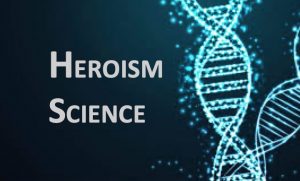
This article is excerpted from the book:
Allison, S. T. (Ed.) (2022). The 12 functions of heroes and heroism. Richmond: Palsgrove.
By Scott T. Allison
I’ve been studying and writing about heroes since 2008, when my dear friend and collaborator, George Goethals, and I began writing our first book on heroism, which appeared in print in the Fall of 2010. The book was called, Heroes: Who They Are & Why We Need Them, and one of the strangest things about it is that while we did discuss who our heroes are, we never really addressed the issue of why we need them. That subtitle was our publisher’s idea, and in our book we conveniently avoided tackling the functions of heroes and heroism in our daily lives. The main reason for our avoidance centered on the fact that at that time we just didn’t know! Heroism science didn’t even exist yet, and a lot of interesting and illuminating research had yet to be conducted on this important topic.
A lot has happened since 2008 and 2009, when we composed that little book. Before briefly delving into the evolution of heroism studies, let’s put all our cards on the table and reveal what the 12 functions of heroism. Let’s also keep in mind that there are no doubt more functions than these 12. If I had to guess, there are probably several dozen more functions. But these 12 represent a start, so here goes:
- Heroes give us hope
- Heroes energize us
- Heroes develop us
- Heroes heal us
- Heroes impart wisdom
- Heroes are role models for morality
- Heroes offer safety and protection
- Heroes give us positive emotions
- Heroes give us meaning and purpose
- Heroes provide social connection and reduce loneliness
- Heroes help individuals achieve personal goals
- Heroes help society achieve societal goals
Take a good look at this list of 12 functions. Some things instantly jump out at us. First, it’s pretty clear that heroism offers benefits that span many dimensions of human well-being. There are basic survival benefits (e.g., safety and healing). There are cognitive benefits (e.g., wisdom). There are motivational benefits (e.g., energy). There are emotional benefits (e.g., hope and positivity). There are social benefits (e.g., less loneliness). There are growth benefits (e.g., development). There are spiritual benefits (e.g., morality). There are existential benefits (e.g., meaning and purpose). And there are creativity benefits (e.g., personal and societal goals).
No wonder we have heroes! We need them badly to get us through this challenging experience called life. Heroes help us survive, and they help us thrive. They help us through our worst times, and they prepare us for our best times. Perhaps the most extraordinary thing about heroes is that they don’t have to be physically present to help us survive and thrive. Just remembering our heroes can do the job for us. Nostalgia for past heroes, both living and dead, can produce these 12 benefits of heroism (Allison & Green, 2020). Research on the impact of losing a parent at a young age has shown that people carry the departed parent with them forever, holding them in their minds, imagining their emotional support and mentoring (Chater, Howlett, Shorter, Zakrewski-Fruer, & Williams, 2022). We all benefit from the memory our heroes, often in ways we’re unaware of.
In 2014, Goethals and I published a chapter on a set of phenomena that we called the Heroic Leadership Dynamic, which describes how our choices of heroes are always in flux. Over the course of the human lifespan, people change in many ways – we pass through various developmental stages, our life circumstances change, and the people and the world around us all change, too. Therefore, our needs and psychological states are always changing. The heroic leadership dynamic proposes that our heroes come and go in ways that match our ever-shifting needs, motivations, and life circumstances. For example, a breast cancer patient may choose a breast cancer survivor as a hero to inspire them. After recovering from cancer, that same person may take up golf and choose a professional golfer as a hero. And so on. Our heroes serve the function of meeting our needs at a particular time and place in our lives, and thus as our lives change, so do our heroes (Allison & Goethals, 2014).
The Heroic Leadership Dynamic proposes two main functions of heroism. First, heroes provide epistemic benefits, also known as wisdom benefits. Heroes and tales of heroism educate us about how to navigate through life, how to meet difficult challenges, how to regulate our emotions, how to resolve the paradoxes of life, how to get help from allies, how to handle our enemies, and how to pass on our hard-earned wisdom to others. Second, heroes provide energizing benefits, which refers to the ability of heroes to inspire us, motivate us, grow us into our best selves, and heal our psychic wounds. Later, our good friend and colleague Olivia Efthimiou added a third benefit, namely, ecological benefits, referring to the ability of heroism to help us interact with larger environmental structures in which we’re all embedded (Efthimiou & Allison, 2017).
In 2015, the highly creative and productive research team in Ireland, headed by Elaine Kinsella and Eric Igou, published a very important article that empirically demonstrated, for the first time, the existence of three functions of heroism (Kinsella, Ritchie, & Igou, 2015). In their Hero Functions Framework, Kinsella et al. found that their participants were able to identify the functions of (1) enhancement, i.e., heroes motivate, inspire, instill hope, and improve morale; (2) moral modeling, i.e., heroes model the values and virtues of society; and (3) protection, i.e., heroes help us, save us, guide us, and defend us against evil and danger. Kinsella and her colleagues also compared the functions of heroism with the functions of leadership, and they present important data showing that heroes offer us unique gifts compared to leaders and role models.
Most recently, my friend and colleague Jeff Green and I have explored some additional functions of heroism based on research on the psychology of nostalgic reminiscences (Hepper et al., 2014). This research shows that people tend to feel nostalgia about heroes from their past — friends and family members, especially. Studies have shown that people also feel nostalgia about their own past heroic accomplishments – for example, the time in the past when they themselves overcame adversity to accomplish something important in their own lives. Heroism, therefore, may be embedded in the content of nostalgic memories. Just as Chater et al. (2022) found that deceased parents continue to move and inspire people, it appears that our fond memories of any past hero can wield positive influence on us long after the hero is gone.
This nostalgic reverie appears to have psychological and behavioral benefits (Sedikides et al., 2015). People higher in nostalgia proneness are more like to be empathic and to behave more prosocially. Nostalgia also increases one’s sense of social connectedness, the depth and range of one’s positive emotions, and one’s ability to achieve personal goals (Allison & Green, 2020). This research suggests that just thinking about our past heroes, or our own past heroic behavior, may serve many important psychological and behavioral functions (Kneuer, Green, & Allison, 2022).
Much more work on the functions of heroism has yet to be done. For more information about the 12 functions of heroism, please check out this book:
Allison, S. T. (Ed.) (2022). The 12 functions of heroes and heroism. Richmond: Palsgrove.
References
Allison, S. T., & Goethals, G. R. (2011). Heroes: What they do and why we need them. New York: Oxford University Press.
Allison, S. T., & Goethals, G. R. (2014). “Now he belongs to the ages”: The heroic leadership dynamic and deep narratives of greatness. In Goethals, G. R., et al. (Eds.), Conceptions of leadership: Enduring ideas and emerging insights. New York: Palgrave Macmillan.
Allison, S. T. & Goethals, G. R. (2020). The heroic leadership imperative: How leaders inspire and mobilize change. West Yorkshire: Emerald.
Allison, S. T. & Green, J. D. (2020) Nostalgia and heroism: Theoretical convergence of memory, motivation, and function, Frontiers in Psychology, 11, 1-13.
Chater, A. M., Howlett, N., Shorter, G. W., Zakrewski-Fruer, J. K., Williams, J. (2022). Reflections experiencing parental bereavement as a young person: A retrospective qualitative study. International Journal of Environments Research and Public Health, 19, 2083.
Efthimiou, O., & Allison, S. T. (2017). Heroism science: Frameworks for an emerging field. Journal of Humanistic Psychology, 58, 556-570.
Franco, Z. E., Blau, K., & Zimbardo, P. G. (2011). Heroism: A conceptual analysis and differentiation between heroic action and altruism. Review of General Psychology, 15, 99-113.
Hepper, E. G., Wildschut, T., Sedikides, C., Ritchie, T. D., Yung, Y. F., Hansen, N., Abakoumkin, G., Arikan, G., Cisek, S. Z., Demassosso, D. B., Gebauer, J. E., Gerber, J. P., González, R., Kusumi, T., Misra, G., Rusu, M., Ryan, O., Stephan, E., Vingerhoets, A. J., & Zhou, X. (2014). Pancultural nostalgia: prototypical conceptions across cultures. Emotion (Washington, D.C.), 14(4), 733–747.
Kinsella, E.L., Ritchie, T.D., & Igou, E.R. (2015). Lay perspectives on the social and psychological functions of heroes. Frontiers in Psychology, 6, 130.
Kneuer, M. A., Green, J. D., & Allison, S. T. (2022). In pursuit of important goals: Nostalgia fosters heroic perceptions via social connectedness. Heroism Science, 7(1), 1-29.
Sedikides, C., Wildschut, T., Routledge, C., Arndt, J., Hepper, E. G., & Zhou, X. (2015). To nostalgize: Mixing memory with affect and desire. Advances in Experimental Social Psychology, 51, 189–273.
Like this:
Like Loading...
 and found one that looked promising. Returning to the counter to ring it up, we found yet another employee waiting for us, making it five on our team, and this fifth Beatle had his own ideas.
and found one that looked promising. Returning to the counter to ring it up, we found yet another employee waiting for us, making it five on our team, and this fifth Beatle had his own ideas. During an occasional lucid moment, I am reminded that I failed. I then comfort myself with the words of my hero, Captain Jean-Luc Picard, who once said: “It is possible to commit no mistakes and still lose. That is not weakness, that is life.”
During an occasional lucid moment, I am reminded that I failed. I then comfort myself with the words of my hero, Captain Jean-Luc Picard, who once said: “It is possible to commit no mistakes and still lose. That is not weakness, that is life.”
